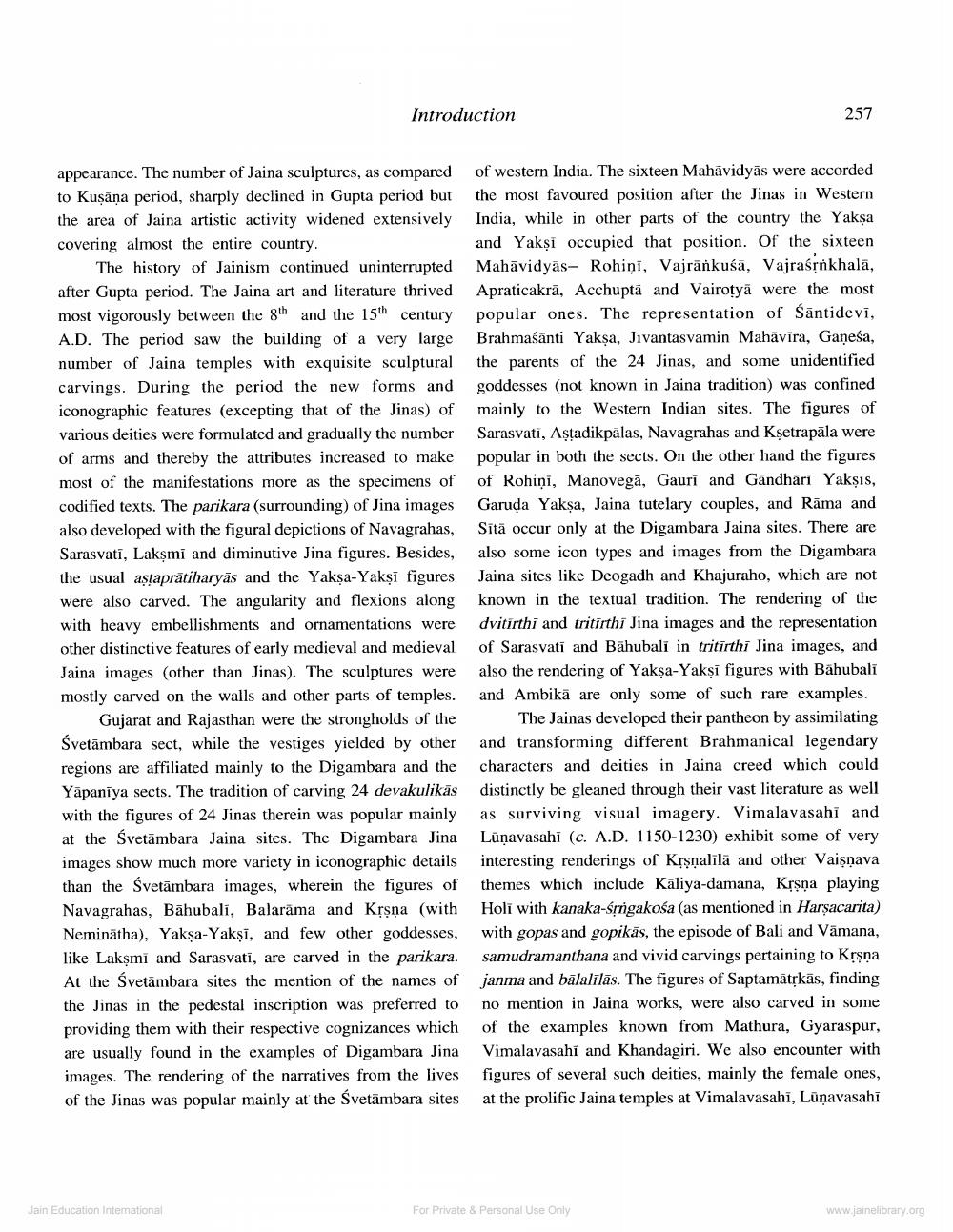________________
Introduction
257
appearance. The number of Jaina sculptures, as compared to Kusana period, sharply declined in Gupta period but the area of Jaina artistic activity widened extensively covering almost the entire country.
The history of Jainism continued uninterrupted after Gupta period. The Jaina art and literature thrived most vigorously between the 8th and the 15th century A.D. The period saw the building of a very large number of Jaina temples with exquisite sculptural carvings. During the period the new forms and iconographic features (excepting that of the Jinas) of various deities were formulated and gradually the number of arms and thereby the attributes increased to make most of the manifestations more as the specimens of codified texts. The parikara (surrounding) of Jina images also developed with the figural depictions of Navagrahas, Sarasvati, Lakşmi and diminutive Jina figures. Besides, the usual astaprātiharyās and the Yakşa-Yakşi figures were also carved. The angularity and flexions along with heavy embellishments and ornamentations were other distinctive features of early medieval and medieval Jaina images (other than Jinas). The sculptures were mostly carved on the walls and other parts of temples.
Gujarat and Rajasthan were the strongholds of the Svetāmbara sect, while the vestiges yielded by other regions are affiliated mainly to the Digambara and the Yāpaniya sects. The tradition of carving 24 devakulikās with the figures of 24 Jinas therein was popular mainly at the Svetāmbara Jaina sites. The Digambara Jina images show much more variety in iconographic details than the Svetāmbara images, wherein the figures of Navagrahas, Bāhubali, Balarama and Krsna (with Neminātha), Yakşa-Yakşi, and few other goddesses, like Lakşmi and Sarasvati, are carved in the parikara. At the Svetāmbara sites the mention of the names of the Jinas in the pedestal inscription was preferred to providing them with their respective cognizances which are usually found in the examples of Digambara Jina images. The rendering of the narratives from the lives of the Jinas was popular mainly at the Svetāmbara sites
of western India. The sixteen Mahavidyas were accorded the most favoured position after the Jinas in Western India, while in other parts of the country the Yakşa and Yaksi occupied that position. Of the sixteen Mahāvidyās- Rohiņi, Vajrānkuśā, Vajraśrnkhalā, Apraticakrā, Acchupta and Vairotyä were the most popular ones. The representation of Sāntidevī, Brahmaśānti Yakşa, Jivantasvāmin Mahävira, Ganesa, the parents of the 24 Jinas, and some unidentified goddesses (not known in Jaina tradition) was confined mainly to the Western Indian sites. The figures of Sarasvati, Astadikpalas, Navagrahas and Kșetrapāla were popular in both the sects. On the other hand the figures of Rohiņi, Manovegā, Gauri and Gāndhāri Yakṣīs, Garuda Yakşa, Jaina tutelary couples, and Rāma and Sītā occur only at the Digambara Jaina sites. There are also some icon types and images from the Digambara Jaina sites like Deogadh and Khajuraho, which are not known in the textual tradition. The rendering of the dvitirthi and tritirthi Jina images and the representation of Sarasvati and Bahubali in tritërthi Jina images, and also the rendering of Yakşa-Yakși figures with Bahubali and Ambikā are only some of such rare examples.
The Jainas developed their pantheon by assimilating and transforming different Brahmanical legendary characters and deities in Jaina creed which could distinctly be gleaned through their vast literature as well as surviving visual imagery. Vimalavasahi and Lūņavasahi (c. A.D. 1150-1230) exhibit some of very interesting renderings of Krsnalilä and other Vaisnava themes which include Kāliya-damana, Krsna playing Holi with kanaka-sựngakośa (as mentioned in Harșacarita) with gopas and gopikäs, the episode of Bali and Vamana, samudramanthana and vivid carvings pertaining to Krsna janma and bālalīlās. The figures of Saptamātņkās, finding no mention in Jaina works, were also carved in some of the examples known from Mathura, Gyaraspur, Vimalavasahi and Khandagiri. We also encounter with figures of several such deities, mainly the female ones, at the prolific Jaina temples at Vimalavasahi, Lunavasahi
Jain Education Intemational
For Private & Personal Use Only
www.jainelibrary.org




